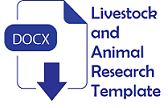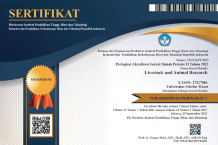Egg quality and cholesterol content of quail fed a combination of Golden snails (Pomacea canaliculata L.) and Azolla pinata
Abstract
This study aims to investigate the combined of the use of Golden snail flour (Pomacea canaliculata L.) and Azolla pinnata as sources of protein and carotene to improve the quality of quail eggs.
Methods:
The materials used in this study were 80 five-week-old laying quails. Golden snails and Azolla pinnata were processed into flour and then mixed with other ingredients (corn, concentrate, bran, palm oil, and premix) until they reached isoprotein and isoenergy (CP = 19% and EM = 2,900 kcal/kg). A Completely Randomized Design was employed, consisting of 4 treatments and 5 replications. Differences among results were analyzed using the Duncan Test. The treatments consisted of: T0 = Control (without Golden Snails and Azolla); T1 = Using 10% Azolla pinnata; T2 = Using 10% Golden snails; P3 = Using 10% Golden snails and 10% Azolla pinnata. The observed parameters included: 1) Egg quality which encompass egg weight, egg yolk index, egg white index, eggshell thickness, and egg yolk color; and egg yolk cholesterol content.
Results:
The results of the study showed that the provision of Golden snails and Azolla showed significantly different results (P<0.05) on egg yolk color, with the highest value observed in quail eggs treated with T1 (using 10% Azolla) of 10.10±0.24. While the cholesterol content of quail eggs did not show a significant difference, but there was a tendency for the treatments involving Azolla (T1 and T3) to exhibit lower cholesterol levels compared to the control (T0) and the treatment using Golden snails (T2).
Conclusions:
The study results indicated an enhancement in egg yolk color and a tendency towards reduced cholesterol content in quail eggs with the administration of 10% Azolla pinata.
Keywords
Full Text:
PDFReferences
REFERENCES
L. Ali, S. I. Gubali, and E. J. Saleh, “Penampilan produksi telur burung puyuhp pada tingkat kepadatan kandang yang berbeda,” Jambura J. Anim. Sci., vol. 2, no. 1, pp. 2–6, 2019, doi: 10.35900/jjas.v2i1.2346.
Y. Retnani, Proses Industri Pakan, 2nd ed. Bogor, 2015.
J. A. Bunga, F. X. Wagiman, . W., and J. H. P. Sidadolog, “Daya makan, diapause dan mobilitas Keong mas (Pomacea canaliculata) pada berbagai kedalaman air,” J. Hama dan Penyakit Tumbuh. Trop., vol. 16, no. 2, p. 147, 2017, doi: 10.23960/j.hptt.216147-154.
K. Saputra et al., “Populasi dan distribusi Keong Mas ( Pomacea canaliculata L .) sebagai sumber pakan ternak pada ekosistem persawahan di Kota Bengkulu,” vol. 13, no. 2, pp. 189–201, 2018, doi: https://doi.org/10.31186/jspi.id.13.2.189-201.
D. C. Miranda, “A study on the nutritive value of Azolla pinnata,” Livest. Res. Int. J., vol. 2, no. 1, pp. 13–15, 2014, [Online]. Available: www.jakraya.com/journa/lri
M. A. Khatun, M. A. S. Mondol, and Y. Akter, “Effect of azolla (Azolla pinnata) based diet on the performance and egg quality of laying hens.,” Int. J. Sustain. Agric. Technol., vol. 4, no. 2, pp. 6–12, 2021, doi: 10.5281/zenodo.5364431.
C. R. Rondonuwu, J. L. P. Saerang, W. Utiah, and M. N. Regar, “Pengaruh pemberian tepung keong sawah (Pila ampulacea) sebagai pengganti tepung ikan dalam pakan terhadap kualitas telur burung puyuh (Coturnix coturnix Japonica),” Zootec, vol. 38, no. 1, p. 1, 2017, doi: 10.35792/zot.38.1.2018.17395.
D. M. Dansou et al., “Carotenoid enrichment in eggs: From biochemistry perspective,” Anim. Nutr., vol. 14, pp. 315–333, 2023, doi: 10.1016/j.aninu.2023.05.012.
R. A. Donadelli, C. G. Aldrich, C. K. Jones, and R. S. Beyer, “The amino acid composition and protein quality of various egg, poultry meal by-products, and vegetable proteins used in the production of dog and cat diets,” Poult. Sci., vol. 98, no. 3, pp. 1371–1378, 2019, doi: 10.3382/ps/pey462.
A. Akerina, “Analisis kandungan kolesterol telur burung (Coturnix coturnix japonica) yang diberikan pakan komersial dengan penambahan tepung rumput laut,” Agrinimal J. Ilmu Ternak dan Tanam., vol. 9, no. 2, pp. 92–100, 2022, doi: 10.30598/ajitt.2021.9.2.92-100.
D. M. S. Tarigan and D. S. T. Manalu, “Azolla pinnata segar sebagai pakan alternatif untuk mengurangi biaya produksi ayam broiler,” J. AGRISEP Kaji. Masal. Sos. Ekon. Pertan. dan Agribisnis, vol. 18, no. 1, pp. 177–186, 2019, doi: 10.31186/jagrisep.18.1.177-186.
S. Alamsyah, S. Kismiati, and V. D. Yunianto, “Penggunaan tepung limbah penetasan telur puyuh dalam ransum terhadap kualitas fisik telur puyuh (Cortunix cortunix japonica),” J. Pengemb. Penyul. Pertan., vol. 13, no. 24, pp. 124–129, 2016, [Online]. Available: https://journal.polbangtanyoma.ac.id/jp3/article/view/78/70
S. I. Gubali, S. Zainudin, and S. Dako, “Produksi Telur Burung Puyuh (Coturnix-coturnix japanica) yang Diberi Tepung Jeroan Ikan Cakalang,” Gorontalo J. Equatorial Anim., vol. 1, no. 1, pp. 22–29, 2022, [Online]. Available: https://ejurnal.ung.ac.id/index.php/gijea/article/view/13660
W. Satria, A. E. Harahap, and T. Adelina, “Kualitas telur puyuh yang diberikan ransum dengan penambahan silase tepung daun ubi kayu,” J. Sain Peternak. Indones., vol. 16, no. 1, pp. 26–33, 2021, doi: 10.31186/jspi.id.16.1.26-33.
dan I. Mustakim, Munir, “Warna dan indeks kuning telur puyuh (Coturnix coturnix japonica) yang diberi tepung daun singkong (Manihot esculenta) dengan level yang berbeda,” J. Gall., vol. 1, no. 3, pp. 88–98, 2023.
A. Alamsyah, E. Basuki, A. Prarudiyanto, and S. Cicilia, “Diversifikasi Produk Olahan Daging Ayam,” J. Ilm. Abdi Mas TPB Unram, vol. 1, no. 1, 2019, doi: 10.29303/amtpb.v1i1.12.
R. A. Alfauzi, B. F. Ariyanto, K. P. Setyawan, M. Sihite, and N. Hidayah, “Potensi kulit jengkol sebagai agen penurun kolesterol daging itik Magelang,” J. Sain Peternak. Indones., vol. 16, no. 1, pp. 98–107, 2021, doi: 10.31186/jspi.id.16.1.98-107.
A. Nurfianti and Y. A. Tribudi, “Kadar malondialdehid (MDA) dan kolesterol pada telur puyuh yang diberi pakan tambhaan tepung pegagan (Centella asiatika),” J. Teknol. Pertan., vol. 17, no. 3, pp. 187–194, 2016, [Online]. Available: https://jtp.ub.ac.id/index.php/jtp/article/view/548
S. Yanto, D. Patang, and A. Program Studi Pendidikan Teknologi Pertanian, “Pemanfaatan Keong mas (Pomacea canaliculata L) dan limbah cangkang Rajungan(Portunus pelagicus) menjadi pakan ternak untuk meningkatkan produksi telur itik,” J. Pendidik. Teknol. Pertan., vol. 3, pp. 137–147, 2017, [Online]. Available: https://ojs.unm.ac.id/ptp/article/view/5525
Refbacks
- There are currently no refbacks.










